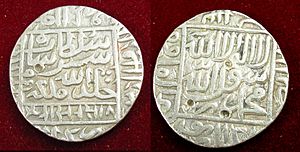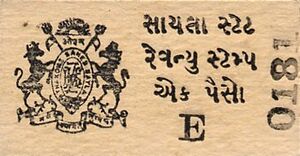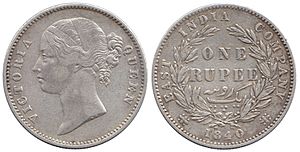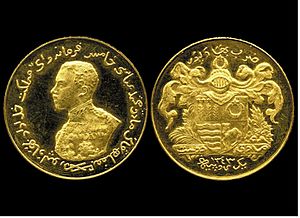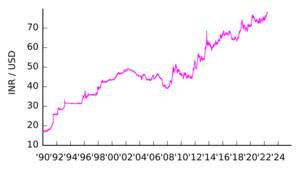History of the rupee facts for kids

The history of the rupee goes way back to ancient India. The word "rupee" comes from the Sanskrit word "rūpya." This word means "wrought silver" or something stamped with an image, like a coin. It also means "shapely" or "impressed." The word "rūpya" was first mentioned in old texts by Pāṇini when talking about coins.
Long ago, around 340–290 BC, Chanakya wrote a book called Arthashastra. Chanakya was a prime minister to the first Maurya emperor, Chandragupta Maurya. In his book, he talked about silver coins called rūpyarūpa. He also mentioned other coins made of gold (suvarṇarūpa), copper (tāmrarūpa), and lead (sīsarūpa). The word rūpa means "form" or "shape."
For some time after the Mauryan Empire, there wasn't a clear money system.
Later, from 1540 to 1545, Sher Shah Suri ruled for five years. He created a new government system and made a silver coin weighing 178 grains. This coin was also called Rupiya. The Mughal rulers who came after him even made coins honoring Hindu gods in 1604–1605. These coins showed Ram and Sita and were made of silver and gold. But they stopped being made right after Akbar died in 1605.
The silver coin continued to be used during the Mughal period, the Maratha era, and even in British India. Some of the first paper rupees were issued by banks like the Bank of Hindostan (1770–1832).
For most of the 1800s, the Indian rupee was based on silver. This caused problems because stronger economies used the gold standard. During British rule, and for the first ten years after India became independent, one rupee was divided into 16 annas. Each anna was split into 4 pices. So, one rupee was equal to 64 pice. In 1957, India switched to a decimal system. The rupee was then divided into 100 naye paise, which means "new paisas." A few years later, the word "naye" was dropped.
For many years in the 1900s, the Indian rupee was also the official money in places like East Africa, Southern Arabia, and the Persian Gulf. These areas were controlled by the British and governed from India.
Contents
The Rupee's Beginnings
The word "rupee" comes from the Sanskrit word "rūpya." It means "wrought silver" or a coin that has been stamped with a design. It also means "shapely" or "impressed." The word comes from rūpa, which means "shape" or "image."
Pāṇini used "rūpya" to mean something beautiful or stamped. The stamped meaning refers to a coin. Later writers explained that these stamped coins included the Dinara, Kedara, and Karshapana. The term Rupataraka was used for someone who checked Karshapana coins. An old Pali text mentions Mashaka-rupa, where Mashaka was a small token coin.
The Arthashastra, written by Chanakya, mentions silver coins as rūpyarūpa. It also talks about gold, copper, and lead coins. Rūpa means form or shape.
During the time between ancient empires, there wasn't a clear money system.
From 1540 to 1546, Sher Shah Suri ruled. He created a new government and issued a silver coin called the Rupiya. This coin weighed 178 grains. The silver coin continued to be used during the Mughal period, the Maratha era (1674–1818), and in British India.
Coins in British India
When the British first settled in India, they made different coins. These coins were accepted in their local areas for trade. For example, coins in Bengal were made in the Mughal style. Coins in Madras mostly followed a South Indian style.
| Indian rupee with George V's image. | |
|---|---|
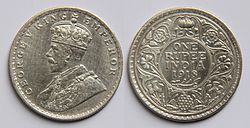 |
|
| Front: Side view of George V with his name. | Back: The coin's value, country, and date. |
| Made of 91.7% silver. | |
In 1717, the British got permission from Emperor Farrukh Siyar to make Mughal money at their mint in Bombay. The British made gold coins called Carolina, silver coins called Anglina, copper coins called Cupperoon, and tin coins called Tinny. By the early 1830s, the British were the main power in India.
The Coinage Act of 1835 made sure all coins across India were the same. The new coins had the image of William IV on the front. The value was written on the back in English and Persian. Coins made after 1840 showed Queen Victoria. The first coins under the British Crown were issued in 1862. In 1877, Queen Victoria became the Empress of India.
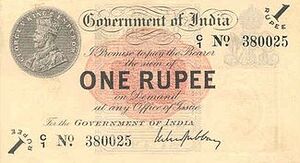
When King-Emperor George V came to the throne in 1911, a famous "pig rupee" was made. On the coin, the king wore a chain with an elephant. But because of poor engraving, the elephant looked like a pig. This made many Muslim people angry, so the image had to be quickly changed.
During the First World War, there was a big shortage of silver. This led to the creation of paper money for one rupee and two and a half rupees. Smaller silver coins were replaced with cupro-nickel ones. The Second World War also changed coins. The standard rupee was replaced by a "Quaternary Silver Alloy" coin from 1940. In 1947, these were replaced by pure Nickel coins.
Right after India became independent, British coins were still used. The money system stayed the same: one rupee was 64 pice, or 192 pies.
Coins and Notes in Independent India
The "Anna Series" was introduced on August 15, 1950. These were the first coins of the Republic of India. The King's image was replaced by the Ashoka's Lion Capital. A corn sheaf replaced the tiger on the one rupee coin. One rupee was still 16 Annas.
In 1957, the "Decimal series" began. The rupee was now divided into 100 'Paisa' instead of 16 Annas. The new coins were called "Naye Paise" (New Paisas). Both the Anna series and the Naye Paise coins were valid for some time. From 1968, the new coins were just called "Paise."
Because of rising prices in the 1960s, small coins made of bronze and other metals were gradually made from aluminium. This started with the new hexagonal 3 paise coin. A twenty paise coin was introduced in 1968 but was not very popular. Over time, 1, 2, and 3 paise coins were stopped in the 1970s. Stainless steel coins for 10, 25, and 50 paise were introduced in 1988. One rupee coins in stainless steel came in 1992.
To save money, notes for Rs 1, Rs 2, and Rs 5 were slowly replaced by coins in the 1990s.
Decimal System (1950s)
The demand for a decimal system had been around for over a hundred years. Sri Lanka changed its rupee to a decimal system in 1869. India's Coinage Act was changed in September 1955 to adopt a decimal system. This change started on April 1, 1957. The rupee's value and name stayed the same. However, it was now divided into 100 'Paisa' instead of 16 Annas. To help people understand, the new decimal Paisa was called 'Naya Paisa' until June 1, 1964. After that, the word 'Naya' was dropped. The coins from that time also showed their value in terms of the rupee to avoid confusion. For example, the one paisa coin said "One hundredth of one rupee."
Economic Challenges
India faced economic challenges that affected its currency. In 1966, India had a trade deficit, meaning it imported more than it exported. The government also had a budget problem. Foreign aid, which helped prevent the rupee's value from dropping, was cut off. India was told to make its trade rules more open. This led to the rupee's value being lowered, which was not popular. The Indo-Pakistan War of 1965 also caused the US and other countries to stop foreign aid to India. This made the rupee's value drop even more. Defense spending was very high in 1965-1966. A drought in 1965-1966 also caused prices to rise sharply.
By the end of 1969, one Indian Rupee was worth about 13 British pence. Ten years later, in 1979, it was worth about 6 British pence. By the end of 1989, it had dropped to 3 British pence. This led to big changes in India's economy.
1991 Economic Crisis
In 1991, India still had a fixed exchange system. This meant the rupee's value was tied to a group of currencies from its main trading partners. India had problems with its balance of payments since 1985. By the end of 1990, it was in serious economic trouble. The government was almost out of money, and its foreign exchange reserves were so low that India could barely pay for three weeks of imports. Like in 1966, India had high inflation and big government budget problems. This forced the government to lower the rupee's value.
Recent Changes
Between 2000 and 2007, the rupee's value became stable. In late 2007, the Indian Rupee reached a high value against the US dollar. This was because a lot of foreign money was invested in India. But this caused problems for exporters and IT companies in India. The trend changed with the 2008 world financial crisis. Foreign investors took their money out of India.
In early 2013, the rupee started losing value again. This was due to slow reforms and less foreign investment. The government announced measures to stop the drop, but they didn't work much. The Prime Minister, Manmohan Singh, said that the drop was due to both global and local reasons. He asked political parties to help the government deal with the crisis.
2016 Demonetisation
In 2016, the government stopped using ₹500 and ₹1,000 notes. This was part of the 2016 Indian banknote demonetisation. New ₹500 notes and a new ₹2,000 note (a first for India) were introduced. Later, new notes for ₹10, ₹20, ₹50, and ₹100 were issued. The old notes of these values are still legal. A new ₹200 note was also introduced and is now used.
2023 Currency Recall In May 2023, the Reserve Bank of India started taking ₹2,000 notes out of circulation. These notes were introduced in 2016. However, they will remain legal money until September 2023. One main reason for removing them is that they are not used much in the Indian market. Their printing had already stopped in 2018-2019.
Banknotes
Early Paper Money
The Bank of Bengal issued notes in three main types:
- Unifaced series: These early notes were printed on only one side. They were issued in values like one gold mohur and Rs. 100, Rs. 250, Rs. 500.
- Commerce series: Later notes had a picture of a female figure representing 'commerce'. These notes were printed on both sides. The bank's name and value were in three languages: Urdu, Bengali, and Devanagari.
- Britannia series: By the late 1800s, the 'commerce' picture was replaced by 'Britannia'. These new notes had more features to prevent fake copies.
British India Banknotes
The Paper Currency Act of 1861 gave the Government the power to print all notes in British India. This was a huge job. The management of paper currency was given to different officials.
- Victoria portrait series: The first British India notes showed Queen Victoria. They were issued in values of Rs 10, Rs 20, Rs 50, Rs 100, and Rs 1,000. They were printed on one side and had two language panels. Security features included a watermark and printed signature.
- Underprint series: This series was introduced in 1867 because many fake Victoria Portrait notes were being made. These notes were issued in values from Rs 5 to Rs 10,000.
- George V series: Notes with the picture of George V were introduced in 1923. His picture became a key feature of all British India paper money. These notes were issued in values from Rs 1 to Rs 10,000.
Reserve Bank Notes in British India
The Reserve Bank of India (RBI) officially started on April 1, 1935. It was allowed to keep issuing Government of India notes until its own notes were ready. The RBI issued its first five-rupee note in 1938. It had the picture of George VI. This was followed by Rs. 10 in February, Rs 100 in March, and Rs 1,000 and Rs 10,000 in June 1938. The first RBI notes were signed by the second Governor, Sir James Taylor.
In August 1940, the one-rupee note was brought back as a wartime measure. During the war, the Japanese made very good fake Indian currency. This led to a change in the watermark. The side view of George VI was changed to a full front view. A security thread was also added for the first time in India. The George VI series continued until 1947.
Republic of India Banknotes
After India became independent in 1947, the Government of India released a new Re.1 note in 1949. At first, people thought Mahatma Gandhi's picture would replace the King's. But finally, the Lion Capital of Ashoka was chosen. The new notes were similar to the old ones. In 1953, Hindi was shown clearly on the new notes. An economic crisis in the late 1960s led to notes being made smaller in 1967. High-value notes, like Rs. 10,000 notes, were stopped in 1978.
The first "Mahatma Gandhi Series" was introduced in 1996. New features included a different watermark, a security thread that could be seen when held to light, a hidden image, and raised printing for people with visual impairments.
The five hundred (₹500) and one thousand rupee notes (₹1,000) were stopped by Prime Minister Narendra Modi on November 8, 2016. These notes are being replaced by the Mahatma Gandhi New Series of notes.
Rupee Value History
The rupee was never equal to the dollar. When India became independent in 1947, its currency was linked to the pound sterling. The exchange rate was one shilling and six pence for a rupee. This meant about Rs 13.33 for one pound. At that time, one dollar was worth about $4.03 pounds. So, in 1947, one rupee was worth about Rs 3.30 to the dollar.
The pound's value was lowered in 1949. India was part of the sterling area, so the rupee's value was also lowered by the same amount. The new dollar exchange rate in 1949 became Rs 4.76. It stayed there until the rupee's value was lowered again in 1966, making it Rs 7.50 to the dollar.
| Year | Exchange rate (INR per USD) |
|---|---|
| 1947 | 3.30 |
| 1949 | 4.76 |
| 1966 | 7.50 |
| 1975 | 8.39 |
| 1980 | 6.61 |
| 1985 | 12.38 |
| 1990 | 17.01 |
| 1995 (Jan) | 37.69 |
| 2000 (Jan) | 44.31 |
| 2005 (Jan) | 43.50 |
| 2006 (Jan) | 46.92 |
| 2007 (Jan) | 49.32 |
| 2008 (Jan) | 43.30 |
| 2009 (1 Jan) | 48.82 |
| 2010 (January) | 46.02 |
| 2011 (1 Jan) | 44.65 |
| 2012 (1 Jan) | 53.06 |
| 2013 (1 Jan) | 54.78 |
| 2014 (1 Jan) | 61.86 |
| 2014 (15 May) | 59.44 |
| 2014 (12 Sep) | 60.95 |
| 2015 (15 Apr) | 62.30 |
| 2015 (15 May) | 64.22 |
| 2015 (19 Sep) | 65.87 |
| 2015 (30 Nov) | 66.79 |
| 2016 (20 Jan) | 68.01 |
| 2016 (25 Jan) | 67.63 |
| 2016 (25 Feb) | 68.82 |
| 2016 (14 April) | 66.56 |
| 2016 (22 Sep) | 67.02 |
| 2016 (24 Nov) | 67.63 |
| 2017 (28 Mar) | 65.04 |
| 2017 (28 April) | 64.27 |
| 2017 (15 May) | 64.05 |
| 2017 (14 August) | 64.13 |
| 2017 (24 October) | 64.94 |
| 2018 (9 May) | 64.80 |
| 2018 (5 Oct) | 74.09 |
| 2018 (9 Oct) | 74.35 |
| 2018 (22 Oct) | 73.66 |
| 2018 (13 Nov) | 72.56 |
| 2018 (4 Dec) | 70.64 |
| 2019 (6 Jan) | 69.53 |
| 2019 (12 Jan) | 70.37 |
| 2019 (1 Feb) | 71.44 |
| 2019 (10 July) | 68.37 |
| 2019 (13 Nov) | 72.15 |
| 2020 (15 Jan) | 70.72 |
| 2020 (6 March) | 74.00 |
| 2020 (21 April) | 76.97 |
| 2020 (5 Nov) | 74.31 |
| 2021 (14 April) | 75.07 |
| 2021 (22 May) | 72.91 |
| 2021 (12 June) | 73.23 |
| 2021 (5 August) | 74.18 |
| 2021 (7 December) | 75.45 |
| 2022 (5 July) | 79.27 |
| 2022 (18 July) | 80.03 |
| 2022 (17 November) | 81.62 |
| 2023 (8 january) | 82.52 |
Other Rupee Currencies
The British India rupees were used in many other places. In Mozambique, they were stamped over. In Kenya, the British East Africa company made rupees and their smaller parts. Early 18th-century East India Company rupees were even used in Australia for a short time.
- Jammu and Kashmir issues: Maharaja Ranbir Singh introduced paper money in 1877. These notes were not very popular and were used for a short time. They had the 'Sun' symbol of the Dogra family.
- Hyderabad issues: The Government of Hyderabad wanted to create its own paper money. But the British did not want Indian princely states to issue paper currency. During the First World War, there was a big shortage of silver. Because Hyderabad State helped the British war effort, the British agreed in 1918. Hyderabad issued paper currency in values of Rs.10/- and Rs.100/-. This money was called the Osmania Sicca (OS). Rupee One and Rupees Five notes were issued later in 1919. Rupees One Thousand notes came out in 1926.
- Burma issues: Burma separated from India in 1938. However, the Reserve Bank of India acted as the banker for the Government of Burma. It was responsible for issuing notes there. In May 1938, the Bank issued Burma notes. These notes were not legal money in India.
- Indo-French issues: The French Indian rupee (FIR) was introduced by France's Bank of Indochina. It was used in French colonies in India.
- Indo-Portuguese issues: The Portuguese Indian Rupia was the money of Portuguese India until 1959. It was divided into 16 Tangas. In 1959, the money changed to the Portuguese Indian Escudo. One Rupia was equal to 6 Escudos.
- Persian Gulf issues: For many years in the 1900s, the Indian rupee was the official money in areas controlled by the British and governed from India. These included East Africa, Southern Arabia, and the Persian Gulf. People were smuggling Indian rupees from India to the Persian Gulf states to buy gold. In 1959, the Indian government introduced the Gulf Rupee. This money was only for use outside India. After India lowered the rupee's value in June 1966, countries still using it, like Oman, Qatar, and the United Arab Emirates, replaced the Gulf Rupee with their own currencies. Kuwait and Bahrain had already done this earlier.
- Emergency issues, Princely states: In the 1940s, during the war, there was a big shortage of small coins across India. Princely states in Western India, like Bikaner and Hyderabad, issued "Cash Coupons" to help with the shortage.
Images for kids
-
Government of India 5 Rupee note (1858)
-
Hyderabad State OS Rs. 100 issue
-
Portuguese Indian 1 rupee, 1924
-
George VI profile portrait, RBI, 1937
-
One rupee, British India
-
George VI profile portrait changed to frontal portrait, RBI, 1943
See also
- Exchange rate history of the Indian rupee
- The Revised Standard Reference Guide to Indian Paper Money
- Rupee
- Indian rupee
- Mauritian rupee
- Pakistani rupee
- Nepalese rupee
- Coinage of India
- Coins of British India
- History of the taka


